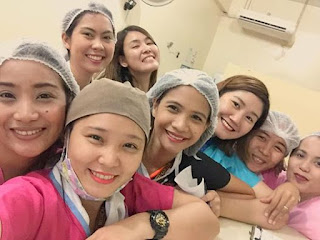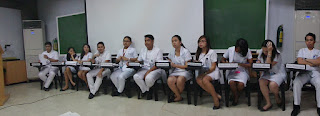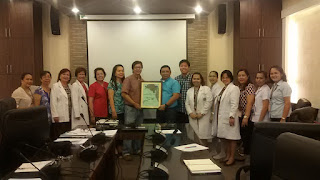My Perception of 2015, the VSMMC Experience
My life these days has been passing by like a blur of activities, and friends have commented on this more than once. So I should not run out of things to write about, maybe I can write about a run down of the things I've been busy with this year before I toss my very full planner into the trashcan:
My car's mileage was 20,000 kms when I bought her. She was three years old. My driver says a taxi cab can obtain that mileage in 3 months. My phone is three years old. I consume 3 fully charged battery packs in a day. I work my phone like a taxi cab because I make a lot of calls, am a heavy texter and my mobile data is perpetually on. Hence, it is time to replace my trusty phone. My body however, I cannot replace as easily. I need to reflect on what I've been doing this past year and focus on what projects to prioritize.
Year end is a good time to reflect and review how best to attack the coming year, so that I don't get burnt out and I can be efficient for a longer time. However, like all other days, I was soooo busy at year end amuck with struggles and challenges that I havent had quiet time to sit down and write.... until now.
In 2015, there were milestones achieved:
As a medical specialist at the regional hospital Vicente Sotto Memorial Medical Center (VSMMC), I wear many hats.
1. EINC Program. As the coordinator for the program on Essential Intrapartum and Newborn Care (EINC), we were able to conduct a hospital-wide orientation from January to March 2015, such that even the security guards know about EINC and endorse it to incoming patients in labor.
In May 2015, I was among the VSMMC delegation to the DOH-sponsored Quality Improvement and Planning Workshop in Manila, where we were advised to "coach" neighboring hospitals and centers - big task!
Last July 2015, members of the DOH monitoring and support team visited VSMMC for the Care for the Small Baby (Mother-Baby Friendly Hospital Initiative, EINC and Kangaroo Mother Care). It was this time that VSMMC was finally KMC-accredited.
Like most health programs, it feels like pushing a heavy kariton. You need to continually push, otherwise when the fervor dies down, so does the implementation. The multi-disciplinary weekly meetings become monthly, and now I can't even remember when we had our last meeting. It is important, however, to continue staff orientation on the EINC policies of the hospital and to be watchdog on its implementation.
2. Program for Young Parents. Although the teen mom clinic in PGH is handled by maternal-fetal medicine specialists, the program on teenage pregnancies was assigned to me. As early as 2014, as a team approach with the Department of Pediatrics, nursing and the Pink Center of VSMMC, we were able to formulate guidelines for handling teenage pregnant patients under our care.
Last June 2015, the Program for Young Parents was identified as one of the Best Practices of our institution and was presented during the 2nd DOH National Staff Meeting. I was honored to have presented the program in behalf of our medical director Dr. Gerardo Aquino. Shared here in our slide presentation during that event, posted with consent.
This program was also featured several times during the HI-5 Impact of DOH under maternal care. I am looking forward to the time that I may pass the baton to another so that more intense attention may be given to this very relevant program.
3. Prevention of Mother to Child Transmission of HIV. As an HIV advocate, I had several speaking engagements, particularly on HIV Management in Pregnancy. Considering that we are a category A area, all pregnant women are advised to have HIV counseling and testing. We managed to increase the uptake of HIV counseling and testing among our pregnant mothers at VSMMC this year. There were also a number of awareness-raising activities attended:
In March 2015, I presented the current POGS clinical practice recommendations on the
Prevention of Mother to Child Transmission of HIV during the Philippine Society of Microbiology and Infectious Disease (PSMID) Cebu chapter 3rd Biennial Convention.
In May 2015, this was the first time that I participated in the International AIDS Candlelight Ceremony at Plaza Independencia, Cebu City, in remembrance of all the lives lost to this HIV epidemic.
In June 2015, we moderated a #HealthXPH tweetchat on
Social Media and the Philippines HIV/AIDS Epidemic, where a lot of our HIV advocates voiced out about the conditions of HIV in our country. Our guide questions included: How can social media reliably increase awareness on HIV? How can social media be used to increase rates of voluntary HIV counseling and testing, specially among high-risk groups? How can social media help improve adherence to anti-retroviral drug therapy?
In September 2015, shortly after the VSMMC HIV/AIDS Core Team (HACT) meeting, I flew to Cagayan de Oro for the POGS X Northern Mindanao chapter 4th annual postgraduate course where I spoke on
HIV and TB in pregnancy.
Last October 2015 we had another #Healthxph tweetchat on HIV, this time tackling the issue on public health policy vs individual patient rights in addressing the
Philippine HIV epidemic. We discussed whether contact tracing of HIV-positive patients should be mandatory, how to find the middle ground between public health policy and individual patient rights to privacy and confidentiality and how social media can help connect public health policy and individual patient rights to privacy and confidentiality.
As we closed the year, I lent myself and my name and my photograph as endorser of the December 2015 AIDS Day Run. Personally running in the 3k Fun Run!
4. Resident Research Coordinator. One of my greatest frustrations is getting residents interested in research work. Finishing their research requirements in the nick of time, our senior residents managed not only to present their research papers but to bag several awards in different research fora:
Catherine Macalos-Timbal's research on serum magnesium and preeclampsia wins first place in the 2015 CIM Research Contest.
Lorelyn Hamoy's work on the "Association of HIV Knowledge, Testing Attitudes and Risk Assessment with the Acceptance Rate of HIV Counseling and Testing among Pregnant Filipino Patients seen in a Tertiary Government Hospital" garnered first place in several research contests including the POGS Cebu Resident Research Contest, the Philippine College of Surgery Cebu and Eastern Visayas chapter. It also won second place in the National POGS Resident Research Contest, 3rd place in the VSMMC 18th Oral Annual Presentation of Resident Research Papers, as well as Best Poster presentation during the PSMID 37th Annual Convention.
Princess Lorezo wins first place in the VSMMC 18th Oral Annual Presentation of Resident Research Papers.
Edilyn Pintac, a top 5 finalist in the oral presentation of research papers during the PSMID 37th Annual Convention, presents her poster on her research entitled "Association of Prevalence and Intensity of Soil-Transmitted Helminth Infection with the Prevalence and Severity of Anemia among Pregnant Filipino Women admitted at VSMMC"
5. Staff Conference Coordinator. We've managed to organize monthly staff conferences on relevant topics on management of complications during pregnancy and gynecologic diseases. For 2015, these were our topics discussed:
- Perimortem CS
- Hemorrhagic Complications in Pregnancy
- Peripartum Trauma
- Management of Preeclampsia and its Cardiac,
Pulmonary and Neurologic Complications
- Cervical cancer prevention
- Abdominal Masses in Pregnancy
- Choriocarcinoma in a 16 year old
- Preterm Labor and Preterm Birth
- Surgical Site Infections
- Breast Cancer
- Violence against Women
- Prevention of Mother to Child
Transmission of HIV Infection
6. Morbidity and Mortality Conferences and the Maternal Death Review. In an attempt to reduce maternal mortality and to improve coordination with major stakeholders in maternal health, we have our maternal morbidity and mortality conferences every month, and as much as possible, we invite resource persons to help us out with our verbal autopsy of cases, especially consultants from the Department of Internal Medicine.

In April 2015 and again in November 2015, VSMMC was represented during the Cebu City Health Department Maternal Death Review by myself, Dr Jessa Alemania and Dr Jalilah Abedin. When the Provincial Health Office conducted their Maternal Death Reviewin December 2015, I also had to attend to react to the cases selected for presentation. Hence, in a personal gesture of genuine help, I offered my services to assist them when coordinating transfer of real emergencies to VSMMC. I envision one day that all pregnant patients needing tertiary care would be transferred way ahead of onset of complications, and that low risk patients can be triaged to birthing centers to decongest the end referral centers to give more attention to complicated high risk pregnancies.


















































